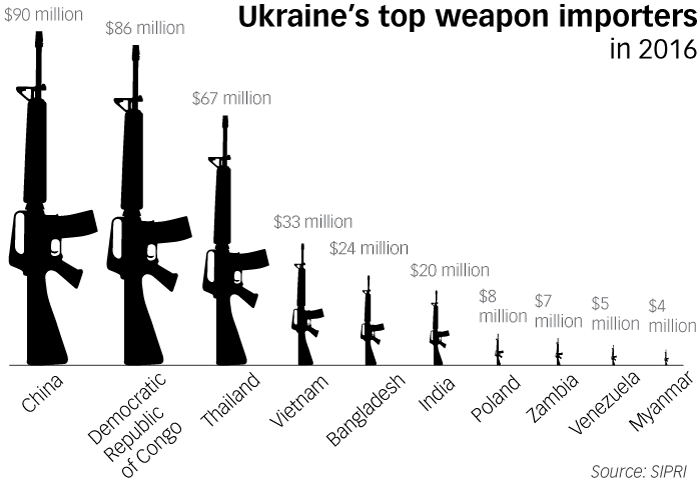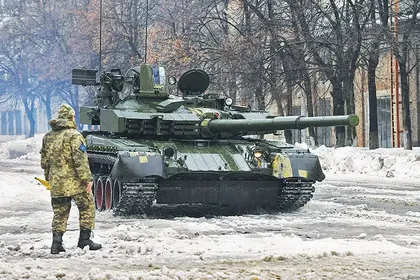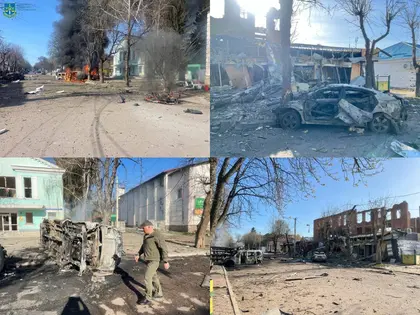For a country at war, Ukraine exports a lot of weapons.
However, the country sells fewer than it did before Russia launched its war on Ukraine in 2014, seizing Crimea and instigating violence in the eastern Donbas that has killed 10,000 people.
The war closed off the Russian arms market, once Ukraine’s biggest weapons buyers.
Ukraine has responded by seeking out new customers and developing new products in a bid to shift away from the dwindling surplus stock that Ukraine inherited after the collapse of the Soviet Union in 1991.
So the search is on not just for new buyers, but new weapons to sell.
Old stock
According to a Swedish think tank, the Stockholm International Peace Research Institute, Ukraine was the world’s 10th biggest weapons exporter in 2016, selling $528 million.
While 53 percent more than in 2015, Ukrainian arms exports took a steep dive in 2014, amid war and recession.
China is emerging from the adjustment as Ukraine’s biggest customer, taking $316 million or 21 percent of Kyiv’s arms sales between 2014 and 2016. Other big buyers over this same period include Thailand ($160 million), India ($116 million), the Democratic Republic of Congo ($86 million), Vietnam ($84 million), and Equatorial Guinea ($80 million).
Overall, in the five-year period from 2011 to 2015, Ukraine accounted for 2.6 percent of weapons sales globally.
But even with the recovery that started in 2016, Ukraine’s sales have a long way to go to get back to pre-war levels. In 2012, arms sales peaked at $1.5 billion.
Moreover, many of Ukraine’s arms exports consists of stocks of repaired Soviet-era weaponry. Despite the ongoing war, Ukraine still sells tens of thousands of firearms: in 2014 to 2015, some Soviet-era 40,000 rifles, 900 machine guns, 590 pistols and 100 assault rifles were sold abroad.
It also sold 230 man-portable air-defense systems, according to Ukraine’s State Service of Export Controls. The United States, Canada, the Czech Republic, Belarus, Uganda, Zambia and the South Sudan are currently among the top buyers of these types of weapons.
Bigger ticket items sold abroad include two An‑26 transport aircraft to Mozambique, one MiG‑29s fighter to Chad and two Mi‑24 helicopters to Nigeria. Also going to Nigeria were 18 122 mm D‑30 howitzers, although they are much needed by Ukrainian forces in the Donbas.
Modernized tanks
Another problem with selling off old stock abroad is that while it brings in foreign currency, it doesn’t generate any work for the arms industry at home.
Ukraine is trying to counter this drawback by using Soviet-era tanks as the basis for modernized armor that it can sell at a premium abroad.
The best known of these “new” products is the T‑84 Oplot main battle tank, designed in 2008 by the Morozov Bureau in Kharkiv on the basis of the Soviet-era T‑80. With its Duplet active armor providing up to 90 percent protection against shaped-charge and armor-piercing projectiles, this advanced combat vehicle is considered one of the most survivable heavy tanks in the world.
The T‑84 Oplot’s defense systems can intercept and neutralize self-propelled rockets, while its Varta system detects laser sighting spots from enemy anti-tank guided missile systems, which it counters with a smoke screen.
The Oplot is armed with a 125mm automatically-loading main gun, along with its coaxial machine gun and anti-aircraft turret. And if fatally hit in the battlefield, the tank increases the survivability of its personnel with an advanced fire suppression system and emergency escape hatches.
According to Ukraine’s defense industry concern Ukroboronprom, the export version of Oplot costs up to $5 million per unit – affordable compared to analogous Western- and Russian-built machines.
However, Ukraine lacks production capacity – it can make only five Oplots a year – and this has hurt its only export order to date, with Thailand. In 2011, Ukraine struck a $241 million deal with Thailand for 49 Oplots, with the possible expansion to 200 tanks.
But Kyiv has repeatedly failed to meet delivery deadlines, and so far has supplied only 25 tanks to the Thai Royal Army, which could well make other potential buyers wary.

Since Russia’s war against Ukraine in 2014, China has become the top buyer of Ukrainian-made weapons.
Another Ukrainian modification of an old Soviet tank is the T‑72UA1 – a modernized export version of the old Soviet T‑72, of which Ukraine inherited at least 2,800.
The mothballed T‑72s, which Ukraine’s military couldn’t afford to keep in service, have since 2011 been used as the basis for the T‑72UA1.
To produce T‑72UA1s, Kyiv Armor Plant equips older T‑72B tanks with the modern Nozh and Kontakt‑1 reactive armor systems and a more powerful 5TDFMA 1050 horsepower engine.
Modernizing and repairing one T‑72UA1 tank costs $250,000, the plant told the Kyiv Post, making it cheaper overall than Russian modified versions of the T‑72. In 2011, Ethiopia and Ukraine struck a $100 million deal for up to 200 tanks, and according to the Stockholm International Peace Research Institute, 143 Ukrainian T‑72UA1s entered service in Ethiopia by 2015.
Similarly, Ukraine exports another upgraded Soviet-era tank, the T‑64B, repaired and modernized to become the T‑64B1M. In 2014, the Kharkiv Tank Plant presented this modification as simplified and cheaper T‑64 version protected with Nozh reactive armor and a safer ammunition magazine. Under a $10-million deal, Ukraine supplied 50 of these tanks to the Democratic Republic of Congo by 2016.
New APCs
Ukraine can, however, offer new products to the arms market. These include a new armored personnel carrier, the BTR‑4 Bucelphalus (named after Alexander the Great’s horse), which has been produced at the Malyshev Tank Factory in Kharkiv since 2008.
The eight-wheel-drive BTR‑4 is among the most advanced vehicles of its type. It can operate on any terrain and under all weather and battlefield conditions, including when nuclear, biological or chemical weapons have been used.
The vehicle can transport up to eight soldiers, and deliver fire from its overhead weapons station, which is equipped with anti-tank guided missiles, a machine gun, and grenade launcher.
The price tag is moderate too, at $1.6 million, so the BTR‑4 has attracted Asian and African customers. Around 10 BTR‑4s were produced for Nigeria in 2014, according to the Stockholm International Peace Research Institute, and five were delivered to Indonesia for ground tests, including two upgraded BTR‑4Ms with the Ukrainian-made BM‑7 Parus combat turret.
Earlier, 60 BTR‑4s were sold to Iraq, although the last delivery of 42 units was rejected as defective. Still, Iraqi-operated BTR‑4s have been in action against Islamic State, and one is reported to have survived a direct rocket hit by Islamic State militants in October 2014 near Baghdad.
Before that, Ukraine’s best selling APC was the BTR‑3U Guardian, produced in Kyiv since 2001. Thailand ordered a batch of BTR‑3Us in a $170 million deal in 2012, and as of 2016 had taken delivery of at least 115 vehicles. These include anti-tank versions armed with Shkval fighting modules, which are equipped with 30 mm cannons, 7.62 mm machine guns, automatic grenade launchers and two Konkurs-M anti-tank guided missile systems.
Aircraft
Exports of Ukrainian warplanes are yet to take off. Most sales abroad were of Soviet surplus, such as the An‑26s Ukraine sold to Mozambique.
But in 2011 the state defense holding Ukroboronprom struck a $45 million deal to deliver three Il‑78 aerial refueling tankers to China, which were repaired and modernized at Mykolaiv Aircraft Repair Plant. Ukraine supplied the third and last plane in 2016.
Ukraine has also sold aircraft repair services to Croatia, in a $14 million deal to overhaul that country’s seven MiG‑21 fighters – a Soviet-made third generation jet still in service in 19 countries. Ukraine also managed to sell Croatia five of its own MiG‑21bis fighters.
To arm MiG and Su fighters, Ukraine can offer the Soviet-era R‑27 air-to-air missile, which is made at the Artem state-run holding in Kyiv. In 2014, Poland purchased 40 R‑27R1 rockets for its MiG‑29 fighters.
In combat, the Ukrainian-made R‑27s have a range of up to 60 kilometers and maximum ceilings of 25 kilometers. Algeria has bought 55 of the missiles; Indonesia and Chad have also made trial purchases.
Ukrainian-made military aircraft engines produced by the Motor Sich company in Zaporizhzhya also sell well. According to the Stockholm International Peace Research Institute, Ukraine has delivered dozens of modern AI‑222 turbofans, used in Yak‑130 and Hondu L‑15 light jets, to Bangladesh, Belarus and Zambia, where training and combat warplane fleets are being developed.
Motor Sich also maintains sales of its older AI‑25 turbofan via China’s sales of its K‑8 fighter, which use the engine in favor of Russian-made versions. China has sold its K‑8 fighters to a dozen countries.
You can also highlight the text and press Ctrl + Enter







Comments (0)